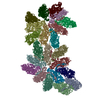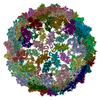[English] 日本語
 Yorodumi
Yorodumi- PDB-7zts: Saccharomyces cerevisiae L-BC virus, open particle, asymmetric re... -
+ Open data
Open data
- Basic information
Basic information
| Entry | Database: PDB / ID: 7zts | ||||||
|---|---|---|---|---|---|---|---|
| Title | Saccharomyces cerevisiae L-BC virus, open particle, asymmetric reconstruction | ||||||
 Components Components | Major capsid protein | ||||||
 Keywords Keywords |  VIRUS / open particle / VIRUS / open particle /  totivirus / asymmetric reconstruction totivirus / asymmetric reconstruction | ||||||
| Function / homology | Major coat protein, L-A virus / L-A virus major coat protein superfamily / L-A virus, major coat protein /  viral capsid / viral capsid /  RNA binding / Major capsid protein RNA binding / Major capsid protein Function and homology information Function and homology information | ||||||
| Biological species |   Saccharomyces cerevisiae BY4741 (yeast) Saccharomyces cerevisiae BY4741 (yeast) | ||||||
| Method |  ELECTRON MICROSCOPY / ELECTRON MICROSCOPY /  single particle reconstruction / single particle reconstruction /  cryo EM / Resolution: 16 Å cryo EM / Resolution: 16 Å | ||||||
 Authors Authors | Grybchuk, D. / Prochazkova, M. / Fuzik, T. / Konovalovas, A. / Serva, S. / Yurchenko, V. / Plevka, P. | ||||||
| Funding support |  Czech Republic, 1items Czech Republic, 1items
| ||||||
 Citation Citation |  Journal: Commun Biol / Year: 2022 Journal: Commun Biol / Year: 2022Title: Structures of L-BC virus and its open particle provide insight into Totivirus capsid assembly. Authors: Danyil Grybchuk / Michaela Procházková / Tibor Füzik / Aleksandras Konovalovas / Saulius Serva / Vyacheslav Yurchenko / Pavel Plevka /  Abstract: L-BC virus persists in the budding yeast Saccharomyces cerevisiae, whereas other viruses from the family Totiviridae infect a diverse group of organisms including protists, fungi, arthropods, and ...L-BC virus persists in the budding yeast Saccharomyces cerevisiae, whereas other viruses from the family Totiviridae infect a diverse group of organisms including protists, fungi, arthropods, and vertebrates. The presence of totiviruses alters the fitness of the host organisms, for example, by maintaining the killer system in yeast or increasing the virulence of Leishmania guyanensis. Despite the importance of totiviruses for their host survival, there is limited information about Totivirus structure and assembly. Here we used cryo-electron microscopy to determine the structure of L-BC virus to a resolution of 2.9 Å. The L-BC capsid is organized with icosahedral symmetry, with each asymmetric unit composed of two copies of the capsid protein. Decamers of capsid proteins are stabilized by domain swapping of the C-termini of subunits located around icosahedral fivefold axes. We show that capsids of 9% of particles in a purified L-BC sample were open and lacked one decamer of capsid proteins. The existence of the open particles together with domain swapping within a decamer provides evidence that Totiviridae capsids assemble from the decamers of capsid proteins. Furthermore, the open particles may be assembly intermediates that are prepared for the incorporation of the virus (+) strand RNA. | ||||||
| History |
|
- Structure visualization
Structure visualization
| Structure viewer | Molecule:  Molmil Molmil Jmol/JSmol Jmol/JSmol |
|---|
- Downloads & links
Downloads & links
- Download
Download
| PDBx/mmCIF format |  7zts.cif.gz 7zts.cif.gz | 7.9 MB | Display |  PDBx/mmCIF format PDBx/mmCIF format |
|---|---|---|---|---|
| PDB format |  pdb7zts.ent.gz pdb7zts.ent.gz | Display |  PDB format PDB format | |
| PDBx/mmJSON format |  7zts.json.gz 7zts.json.gz | Tree view |  PDBx/mmJSON format PDBx/mmJSON format | |
| Others |  Other downloads Other downloads |
-Validation report
| Arichive directory |  https://data.pdbj.org/pub/pdb/validation_reports/zt/7zts https://data.pdbj.org/pub/pdb/validation_reports/zt/7zts ftp://data.pdbj.org/pub/pdb/validation_reports/zt/7zts ftp://data.pdbj.org/pub/pdb/validation_reports/zt/7zts | HTTPS FTP |
|---|
-Related structure data
| Related structure data |  14963MC  7qwxC  7qwzC  7zufC M: map data used to model this data C: citing same article ( |
|---|---|
| Similar structure data | Similarity search - Function & homology  F&H Search F&H Search |
- Links
Links
- Assembly
Assembly
| Deposited unit | 
|
|---|---|
| 1 |
|
- Components
Components
| #1: Protein | Mass: 78393.812 Da / Num. of mol.: 110 / Source method: isolated from a natural source / Source: (natural)   Saccharomyces cerevisiae BY4741 (yeast) / References: UniProt: Q87026 Saccharomyces cerevisiae BY4741 (yeast) / References: UniProt: Q87026 |
|---|
-Experimental details
-Experiment
| Experiment | Method:  ELECTRON MICROSCOPY ELECTRON MICROSCOPY |
|---|---|
| EM experiment | Aggregation state: PARTICLE / 3D reconstruction method:  single particle reconstruction single particle reconstruction |
- Sample preparation
Sample preparation
| Component | Name: Saccharomyces cerevisiae virus L-BC (La) / Type: VIRUS / Entity ID: all / Source: NATURAL |
|---|---|
| Molecular weight | Experimental value: NO |
| Source (natural) | Organism:   Saccharomyces cerevisiae virus L-BC (La) Saccharomyces cerevisiae virus L-BC (La) |
| Details of virus | Empty: YES / Enveloped: NO / Isolate: OTHER / Type: VIRUS-LIKE PARTICLE |
| Natural host | Organism: Saccharomyces cerevisiae / Strain: BY4741 |
| Virus shell | Diameter: 400 nm / Triangulation number (T number): 2 |
| Buffer solution | pH: 7.5 / Details: 20 mM Tris-HCl pH 7.5, 50 mM KCl, 10 mM MgCl2 |
| Specimen | Conc.: 1.5 mg/ml / Embedding applied: NO / Shadowing applied: NO / Staining applied : NO / Vitrification applied : NO / Vitrification applied : YES : YESDetails: Virus was isolated by shearing with glass beads and overnight precipitation in 5% PEG-4000 and 500 mM NaCl |
| Specimen support | Details: Glow discharge current 7 mA / Grid material: COPPER / Grid mesh size: 200 divisions/in. / Grid type: Quantifoil R2/2 |
Vitrification | Instrument: FEI VITROBOT MARK IV / Cryogen name: ETHANE-PROPANE / Humidity: 100 % / Chamber temperature: 277 K / Details: blot force 0, blot time 3 s, 4 C, 100% humidity |
- Electron microscopy imaging
Electron microscopy imaging
| Experimental equipment |  Model: Titan Krios / Image courtesy: FEI Company |
|---|---|
| Microscopy | Model: FEI TITAN KRIOS |
| Electron gun | Electron source : :  FIELD EMISSION GUN / Accelerating voltage: 300 kV / Illumination mode: FLOOD BEAM FIELD EMISSION GUN / Accelerating voltage: 300 kV / Illumination mode: FLOOD BEAM |
| Electron lens | Mode: BRIGHT FIELD Bright-field microscopy / Nominal magnification: 130000 X / Nominal defocus max: 1700 nm / Nominal defocus min: 700 nm / Cs Bright-field microscopy / Nominal magnification: 130000 X / Nominal defocus max: 1700 nm / Nominal defocus min: 700 nm / Cs : 2.7 mm / C2 aperture diameter: 30 µm / Alignment procedure: ZEMLIN TABLEAU : 2.7 mm / C2 aperture diameter: 30 µm / Alignment procedure: ZEMLIN TABLEAU |
| Specimen holder | Cryogen: NITROGEN / Specimen holder model: FEI TITAN KRIOS AUTOGRID HOLDER / Temperature (max): 80 K / Temperature (min): 70 K |
| Image recording | Average exposure time: 6 sec. / Electron dose: 36 e/Å2 / Detector mode: COUNTING / Film or detector model: GATAN K2 SUMMIT (4k x 4k) / Num. of grids imaged: 1 / Num. of real images: 11977 |
| EM imaging optics | Energyfilter name : GIF Bioquantum / Energyfilter slit width: 10 eV : GIF Bioquantum / Energyfilter slit width: 10 eV |
| Image scans | Sampling size: 5 µm / Width: 3600 / Height: 3600 / Movie frames/image: 30 / Used frames/image: 1-30 |
- Processing
Processing
| Software | Name: UCSF ChimeraX / Version: 1.3/v9 / Classification: model building / URL: https://www.rbvi.ucsf.edu/chimerax/ / Os: Linux / Type: package | ||||||||||||||||||||||||||||||||||||||||||||||||||
|---|---|---|---|---|---|---|---|---|---|---|---|---|---|---|---|---|---|---|---|---|---|---|---|---|---|---|---|---|---|---|---|---|---|---|---|---|---|---|---|---|---|---|---|---|---|---|---|---|---|---|---|
| EM software |
| ||||||||||||||||||||||||||||||||||||||||||||||||||
CTF correction | Type: PHASE FLIPPING AND AMPLITUDE CORRECTION | ||||||||||||||||||||||||||||||||||||||||||||||||||
| Particle selection | Num. of particles selected: 72705 | ||||||||||||||||||||||||||||||||||||||||||||||||||
3D reconstruction | Resolution: 16 Å / Resolution method: FSC 0.143 CUT-OFF / Num. of particles: 1120 / Algorithm: FOURIER SPACE / Num. of class averages: 1 / Symmetry type: POINT | ||||||||||||||||||||||||||||||||||||||||||||||||||
| Atomic model building | Protocol: FLEXIBLE FIT / Space: REAL / Details: Initial model generated by RaptorX server |
 Movie
Movie Controller
Controller





 PDBj
PDBj